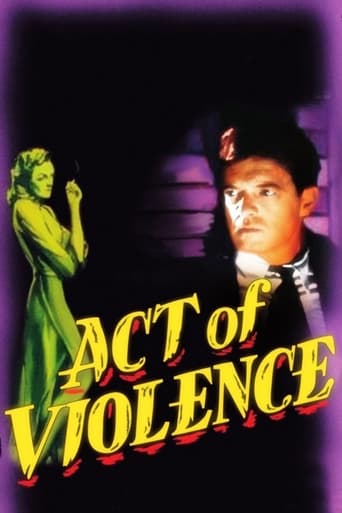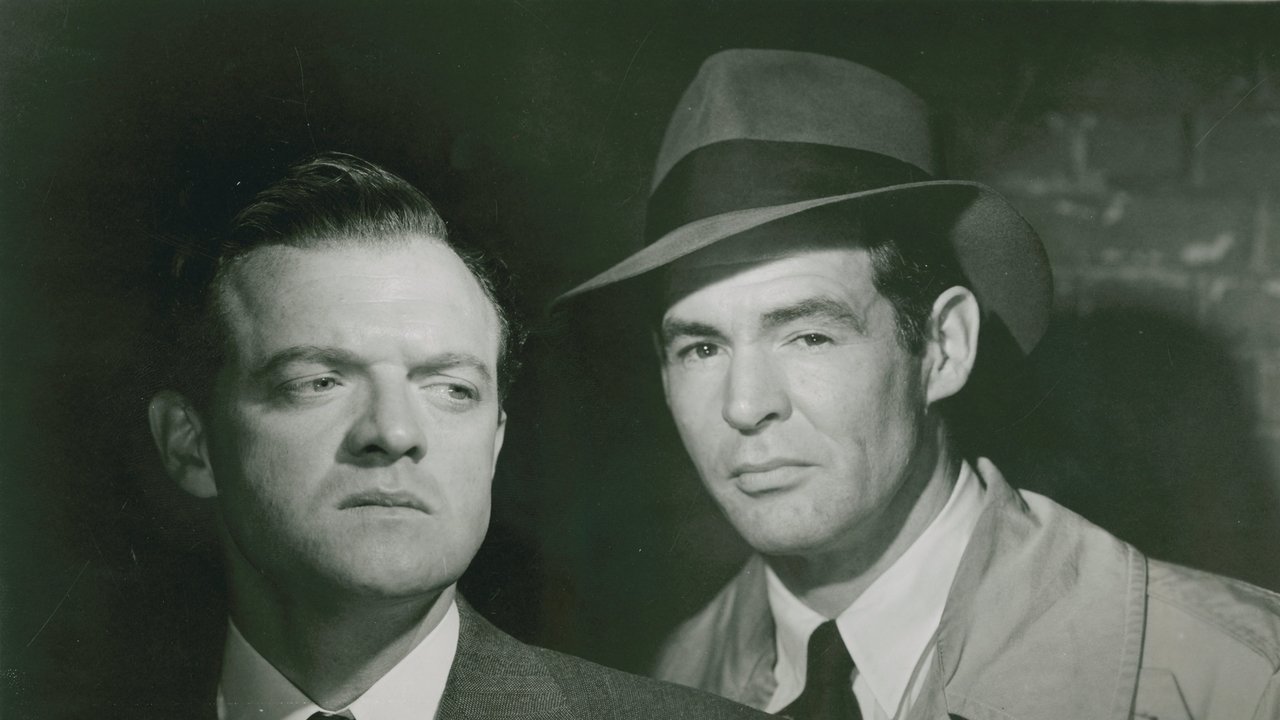davidcarniglia
Incredibly thrilling noir film. Well-cast and acted, atmospheric, with a classic noir plot. From the very first scene in Robert Ryan's dingy apartment as he retrieves his pistol, to the final scene in the railyard that finds Van Heflin mistakenly killed by the hood he never wanted to hire, neither of the protagonists can escape the web of the past.The fact that Ryan and Heflin's feud goes back to a dilemma from the war ensures that there's nothing they can do to change their collision course. From the bright new suburbs and mountain lake, the characters stumble through the dank, windy sleaze of in the dingy corners of nightime L.A.Both characters are tragically flawed, yet both are sympathetic. We can see why Ryan seeks revenge for Heflin's wartime collaboration, while Heflin felt forced to make the best deal he could with their duplicitous Nazi captors. Just when Heflin leaves himself open to the vengeful Ryan, another mistake aborts their reconciliation.We are left with Ryan assuming or at least acknowledging responsibility for his part in the feud, by telling the assembled crowd at Heflin's heroic death that he will tell his wife. We can imagine that, even in her rage against Ryan for accelerating the feud, she at least will know that her husband was shot trying to warn his enemy about the hired killer, and died trying to 'square' things by confronting the killer.His past misdeed that allowed his fellow prisoners to die, is in a sense redeemed by killing the Nazi-like gangster. Johnny is an especially slimy hood; when he smells money by offering to kill Ryan, and Heflin hesitates to commit himself, Johnny remarks that it's best to "get rid of this guy, and be sorry later."Both Ryan and Heflin appear sickened by their ordeal, enduring a nightmarish slugfest with an underworld of bars, cheap hotel rooms, alleys, tunnels, and the iconic trainyard that seems to bind them to a world without nature or emotion.One of the best, if not the best film noir.
Martin Bradley
Fred Zinnemann made "Act of Violence" in 1948 before the solid, literary adaptations that made his reputation. It's a terrific piece of work, a truly taut thriller and yes, you could say very Un-Zinnemann like. The act of violence of the title is two-fold. It could refer to Robert Ryan's desire to kill Van Heflin or it could equally refer to the act of violence that Heflin was responsible for when a number of his men, during the war, were murdered by the Nazis after he betrayed them. Heflin now lives a life of almost desperate respectability in a small Californian town with wife Janet Leigh and it's to there that Ryan tracks him down.This is a morally complex film that was never the success it deserved to be. Both Heflin and Ryan are superb and Leigh, too, is excellent as the wife trying to come to terms with her husband's past. There is also a terrific, and sadly neglected, supporting turn from Mary Astor as an ageing prostitute. It was shot magnificently and on actual locations, in black and white, by Robert Surtees and it remains one of Zinnemann's very finest films.
Scott LeBrun
Very enjoyable machine-gun paced film noir tells a solidly entertaining, tight story in atmospheric and potent fashion by director Fred Zinnemann. It's noteworthy for the way it portrays the effects of WWII on the minds of the men who fought it. Our two main characters are hunter and the hunted, but are not so different, and they're both created in shades of grey. One made some awful mistakes, but must suffer the pangs of guilt, and the other has allowed his hatred and need for revenge to completely dominate his life, to the exclusion of all else. The supporting cast is strong, and Zinnemann and company just get right into the action, saving all of the credits for the end, which would have been a real rarity in this era.Van Heflin plays Frank Enley, a successful building contractor who finds that he is being relentlessly pursued by one of his old war comrades, Joe Parkson (Robert Ryan). Joe simply can NOT forgive Frank for his actions during their time as prisoners of war, and is intent on killing him. Soon Frank must take it on the lam, while other people involved in the drama, such as Franks' terrified wife Edith (Janet Leigh), and Joes' distraught girlfriend Ann (Phyllis Thaxter), try to dissuade Joe from continuing in his mission.There's no filler here, just an engaging, straightforward story (authored by Collier Young, and written for the screen by Robert L. Richards). Things really kick up a notch once the frazzled Frank goes on the run, and get truly interesting when a concerned call girl, Pat (Mary Astor), takes some pity on Frank and tries to help him out. Things only get worse when he's introduced to characters such as Gavery (Taylor Holmes) and Johnny (Berry Kroeger). Heflin and Ryan are both compulsively watchable, the young and gorgeous Leigh is a joy, Holmes and Kroeger are great fun to watch, and Astor is fantastic and a real standout among the cast.For those people who love this genre and also like a bit of action to go with it, "Act of Violence" is a satisfying bit of entertainment.Eight out of 10.
Steffi_P
In the period immediately after Word War Two there was this massive divergence of moods in cinema, with fantastical escapism on the one hand, and dark pessimism on the other. This was particularly pronounced at MGM. Although the Arthur Freed unit was carrying on the studio's reputation for dreamlike extravagance, new production chief Dore Schary was also pushing a line of frank and gritty "message" movies, many of which dealt directly with the recent conflict.Act of Violence runs like a kind of dark flipside to the sublimely poignant Best Years of Our Lives, which won Best Picture for MGM a few years earlier. The director is Fred Zinnemann, who would later film a couple of Best Pictures himself, but at this point was still honing his craft in the B-unit. As in the handful of other features he had made up to this point, his primary concern seems to be creating atmosphere and tension through use of space and lighting. Virtually every shot is filled with streaking shadows and stifling frames, and to be honest this is all laid on a bit too heavily, even if it is very precise. Ironically though, his aim to give the picture this consistent claustrophobic feel means that sometimes he is forced to achieve it more subtly – for example in the shot where Robert Ryan crosses the road in front of the military parade, Zinnemann frames the action neatly with objects and people. The effect is the same but it looks very natural and unforced.Zinnemann also gets to prove his ability at handling action scenes. This is something directors usually perfect sooner than they do drama, which again is ironic for Zinnemann as he would spend most of his later career making deep dramatic pictures with little action. His staging of drama is coming along here though. He does a lot of long takes in dialogue scenes, where against cinematic convention one actor has their back to the camera whilst talking, thus focusing us on the reactions of the listener. One of the strongest pieces of direction however is the way Zinnemann introduces the two lead characters. We first see Ryan walking from a distance, then closer to, but from behind, we then see he has a gun, and then we finally pan up to his face. We are thus given clues as to the kind of man he is and what he may be capable of before we are allowed to connect with the character. The opposite approach is taken for Van Heflin, who is introduced to us with a big facial close-up, which would have been meaningful to audiences of the day as they would know Heflin and the sort of characters he played. From this point on Zinnemann allows the story to deconstruct Heflin's stereotype and add flesh to Ryan's.This intelligent focus on actors naturally brings out the best in the performances. Heflin's is strong if a tiny bit overdone at times. He probably relished this chance to show off his range. Ryan sadly doesn't get to do enough with this character, but he has great presence, and that is essentially what his character is for most of the movie – a presence. Mary Astor is great too – another player with fantastic range. I'll also mention Berry Kroeger, who plays the hit-man Johnnie, and was clearly cast as a face to fit the part, yet he does a pretty good acting job as well.One thing that does link these darker MGM post-war flicks with the studio's lighter upbeat fare is a kind of melodramatic overstatement, which is great in the right place but harms a picture like Act of Violence. In spite of the staccato, atonal intro, the music is largely schmaltzy strings spoiling the sincerity of the dramatic moments. The dialogue is fairly trite and unmemorable. It is mainly the good acting and competent direction which saves this one.


 AD
AD




